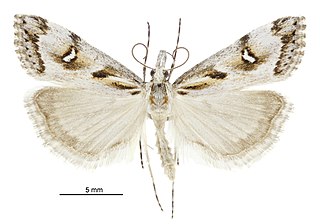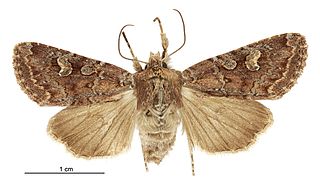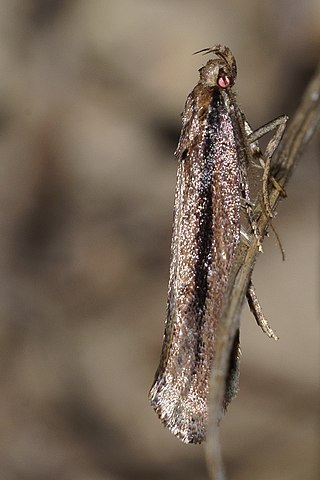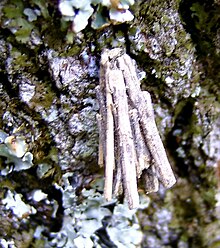
The map-winged swift is a moth belonging to the family Hepialidae and has a patchy distribution throughout Eurasia. The species was first described by Charles De Geer in 1778. It was previously placed in the genus Hepialus and some references still place it there.

Notocelia rosaecolana is a moth of the family Tortricidae. It is found in the Palearctic realm, where it has been recorded from China, Mongolia, Korea, Japan, Iran, Central Asia, Russia and Europe.

Mesapamea secalis, the common rustic, is a moth of the family Noctuidae. The species was first described by Carl Linnaeus in his 1758 10th edition of Systema Naturae. It is found in Europe, north-west Africa, Turkey and northern Iran.

Diarsia dahlii, the barred chestnut, is a moth of the family Noctuidae. The species was first described by Jacob Hübner in 1813. It is found in Europe, through the Palearctic east to the Kamchatka Peninsula, northern China and Japan.

Xylena vetusta, the red sword-grass, is a moth of the family Noctuidae. The species was first described by Jacob Hübner in 1813. It is found in the Palearctic realm from northwestern Africa through Europe and Asia up to central Siberia. In the north it is found up to the Arctic Circle and Iceland.

Protolampra sobrina, the cousin german, is a moth of the family Noctuidae. The species was first described by Philogène Auguste Joseph Duponchel in 1843. It is found in most of Europe, then east across the Palearctic to Siberia, Altai, Irkutsk, Kamchatka and Korea.

Apamea lateritia, the scarce brindle, is a moth of the family Noctuidae. It is found in much of the Palearctic. It is a sporadic migrant in Great Britain, where it is recorded from the east and south-east coasts.

Stigmella continuella is a moth of the family Nepticulidae. It is found from Fennoscandia to the Pyrenees, Alps and Hungary, and from Ireland to central Russia and Ukraine, east to the eastern part of the Palearctic realm.
Eriocraniella aurosparsella is a moth of the family Eriocraniidae. It was described by Thomas de Grey in 1880. It is found from southern Oregon south through the coastal ranges of California to Santa Clara County and Santa Cruz Island.
Eriocraniella xanthocara is a moth of the family Eriocraniidae. It was described by Davis in 1978. It is found in California.

Ochsenheimeria urella is a moth of the family Ypsolophidae. It is found in large parts of Europe, except the Iberian Peninsula, most of the Balkan Peninsula, Ukraine and Lithuania.
Apophatus bifibratus is a moth of the family Palaephatidae. It was described by Donald R. Davis in 1986. It is found in the temperate Valdivian forests of southern Argentina and Chile.

Pectinivalva brevipalpa is a moth of the family Nepticulidae. It is found in New South Wales.

Gadira leucophthalma, the beaked moss moth, is a moth in the family Crambidae. It is endemic to New Zealand. It is found in the south eastern side of the South Island down to Banks Peninsula. G. leucophthalma inhabits the foredunes of coastal areas. The larval host is unknown but it has been hypothesised that the larvae feed on moss. The adult moths are day flying although some specimens have been trapped at night via light traps. Adults are commonly on the wing from March to April. This species has been classified as Nationally Vulnerable by the Department of Conservation.

Glaucocharis pyrsophanes is a moth in the family Crambidae. It was described by Edward Meyrick in 1882. It is endemic to New Zealand.

Pyrgotis eudorana is a species of moth of the family Tortricidae. It is endemic in New Zealand and has been observed in both the North and South Islands. However it is regarded as a rare insect. This species inhabits native forest. Larvae exclusively feed on Muehlenbeckia australis and adults are on the wing from November to April. Adults are attracted to light.
Chlamydastis hemichlora is a moth of the family Depressariidae. It is found in French Guiana.

Ichneutica agorastis is a moth of the family Noctuidae. This species is endemic to New Zealand. This moth is similar in appearance to two other species in the genus but can be distinguished through the colour and size of its forewings. This species is found in the South Island and Stewart Island in open habitats in the subalpine zone. However, in Southland I. agorastis can be found down to sea-level. Adult moths are on the wing between January and April. The life history and host species are unknown.

Atomotricha versuta is a moth in the family Oecophoridae first described by Edward Meyrick in 1914. It is endemic to New Zealand and has been observed in both the North and South Islands. The adults of the species are variable in appearance but the three principal variteis are connected b intermediate forms. The female of the species is brachypterous and is incapable of flight. Both the adult male and female have been observed resting on fences during cold winter nights.

Trachypepla ingenua is a moth of the family Oecophoridae first described by Edward Meyrick in 1911. It is endemic to New Zealand and has been collected in both the North and South Islands. This species is one of the larger in the genus Trachypepla and the colouration of the adults imitates bird droppings. The preferred habitat of T. ingenua is native forest and adults are on the wing from December to February.
















